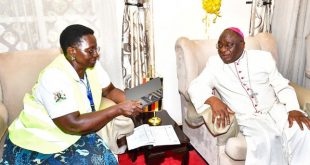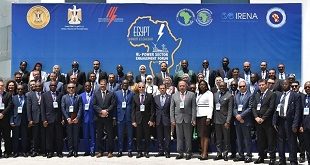
WHO releases new guidelines; but how will Uganda drive more patients to the hospital?
Every Friday morning at the Uganda Cancer Institute is free screening time. Being the biggest cancer facility in the country, coupled with ever increasing cases, one would expect to see some quite big numbers. But that is rarely the case.
In fact, the two medical workers at the screening desk often spend the time chitchatting. At about 10am on Feb.10, seeing no single patient, I asked them why there are rarely people screening for cancer.
“People fear cancer results,” one said.
But just a few metres away on the opposite treatment side, a sizeable number patients could be seen. Many hurdled in groups, some still wrapped up in their warm clothing, blankets and sheets, often with protruding tumors on the face and others with bold heads probably from tough cancer treatment. A few walked around. Some had been here for days and others weeks, they said, hoping in vain to see a doctor.
Workers at the Institute say the contrast between the screening side and treatment side does not surprise them. Dr. Noleb Mugisha, one of the few oncologists at the50-year Institute located at Mulago Hill, says there is a scramble at the treatment clinic because people are in pain.
“They only report after their tumors start paining and that’s why we lose them. Any doctor prides in treating to cure but by the time they come here their cancers are irreversible and there’s nothing much we can do,” he says bare hiding his frustration. Many of his colleagues share his view.
It’s one problem that experts at the World Health Organisation (WHO) have recognised and want to reverse. On the eve of Feb.04 World Cancer Day, they released a new set of guidelines to early diagnosis and treatment of cancer aimed at ensuring increased survival.
The country-level intervention guidelines are summarised in three steps; improving public awareness of different cancer symptoms and encourage people to seek care when these arise, investing in strengthening and equipping health services and training health workers so they can conduct accurate and timely diagnostics, and lastly ensuring people living with cancer can access safe and effective treatment, including pain relief, without incurring prohibitive personal or financial hardship.
The guidelines come after the organisation’s new figures showed a grim fact that 8.8 million of the 14 million people diagnosed with cancer globally each year die because their cases are identified at an advanced stage, when they are harder to treat successfully.
Cancer is now responsible for almost 1 in 6 deaths globally. More than 14 million people develop cancer every year, and this figure is projected to rise to over 21 million by 2030. Progress on strengthening early cancer diagnosis and providing basic treatment for all can help countries greatly reduce these numbers.
In Uganda, of the 4000 cases recorded at the Institute last year, 80% died. The most common cancers were Kaposi’s sarcoma, which is common among people living with HIV/AIDS, cervical, breast, prostate and cancer of the esophagus. Most of the newly diagnosed cases were either in second stage or forth stage according to Mugisha.
In its guidelines, WHO throws the ball of reversing the problem trend into the hands of healthcare managers. They recommend that countries; especially middle and low income like Uganda where the problem is greater, need to prioritise investment in diagnostic services that include imaging, laboratory tests, and pathology which are key to helping detect cancers and plan treatment. Strategies to improve early diagnosis according to the organisation can be readily built into health systems at a low cost. In turn, effective early diagnosis can help detect cancer in patients at an earlier stage, enabling treatment that is generally more effective, less complex, and less expensive. Several studies done in high-income countries have shown this can actually work. Evidence shows treatment for cancer patients who have been diagnosed early are 2 to 4 times less expensive compared to treating those diagnosed with the disease at more advanced stages. And, this does not only reflect in terms of what one pays for medical service but also the fact that one can continue to work and support their families if they access effective treatment in time.
Dr. Gerald Mutungi, the Commissioner Non- Communicable Diseases at the Ministry of Health, is alive to this fact but says the first challenge is how they interest as many Ugandans to “fall in love with the hospital”.
“The culture of going for periodic medical reviews is dead even among the elite,” he says.
For instance, the cancer institute has dedicated the whole month of February to free screening of common cancers like that of the prostate, ovarian, cervical, leukemia and breast every day but by Feb.10, only 80 people had reported for the service.
Mutungi says his department has resolved to first invest in public awareness programmes mainly focusing on prevention through educating people about the dangers of alcohol and tobacco smoking – biggest risk factors and the importance of a healthy diet in addition to keeping physically active.
To Health Minister Jane Ruth Aceng, reducing the cancer diseases burden in Uganda should not be viewed as the duty of the government only. Instead, each person can take responsibility as more than a third of all cases are preventable with simple lifestyle measures. She says apart from coming up with good policies, investing in palliative care, and ensuring access to vaccination programmes, there is not a lot that the government can do.
She listed measures that the government has put in place to prevent certain cancers. She listed vaccination of girls against the Human Papilloma Virus that causes cervical cancer which is on-going among girls aged 10. Even adults in 39 high burden districts are being vaccinated against HPV. Vaccination for children is now part of the routine immunisation schedule.
However, as the struggle of ensuring that more people test early continues, the Uganda Cancer Institute, even with its status as the region’s center of excellence in oncology treatment and research, still faces major treatment challenges. These range from availing the necessary drugs to specialised treatments like radiotherapy.
Dr. Jackson Orem, the Executive Director of the Institute says their main plan is to ensure that the need for an individual to pay out of their pockets for cancer medicine is reduced. He says this could be the reason why some patients stay in their homes to die in pain.
The events that happened after the only radiotherapy machine at the institute broke down perhaps explain Orem’s argument. Even when the Agha Khan hospital in Kenya offered to provide 400 patients with free radiation treatment, only 50 of the 100 screened took the offer partly because they could afford the other costs involved. Many were turned away because they, for instance, could not buy out of their pockets accompanying medicines and welfare.
Orem promises a new machine to be in place by May.
“Two processes are going on concurrently; renovation of the old bunker and installation of the new machine. It’s being made in Czech Republic and will be shipped as soon as renovation is done. 50% of the work is done,” he said adding construction of the new bunker to house six other machines for different kinds of cancer treatment such as brachytherapy is at 52% progress.
Once the two are complete and can offer treatment, Orem is hopeful that some deaths will be averted and many lives will be extended.
****
editor@independent.co.ug
 The Independent Uganda: You get the Truth we Pay the Price
The Independent Uganda: You get the Truth we Pay the Price


